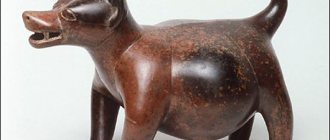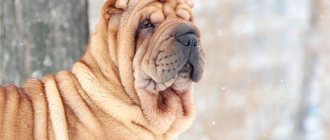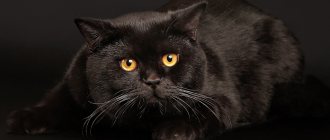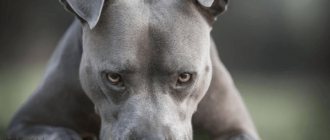Origin story
This breed is so ancient that all the details of its origin are unknown to anyone. There is information that the great Chinese Emperor Qin Shi Huang deliberately destroyed all records and stud books that described the history of the Shar Pei. The motives remain unknown to this day.
It is believed that Shar-Peis descended from the most ancient mastiffs and smooth-haired Chow Chows. But this is evidenced only by anatomical similarities and some common character traits. There is only one exact statement, which was obtained as a result of a study of Shar Pei DNA - this breed has existed on earth for more than three thousand years. Therefore, we can conclude that the Shar Pei became one of the 4 primitive descendants of the very first dog.
The history of this breed, which was preserved on paper, is very interesting. For many centuries, these dogs were distributed only on the coast of the South China Sea, as well as in the provinces of southern China. In the 3rd-2nd century BC, Shar Peis were the most popular dog among the Chinese people. This is confirmed by numerous clay figurines found during excavations of ancient Chinese tombs, which depict a serious, frowning dog covered with skin folds.
The breed was already on the verge of extinction when World War II began. Cold and hunger significantly reduced the number of remaining Shar-Peis. There is evidence that in the early 50s there were only a few litters of this dog in China. And only in 1971 the first Shar Pei was brought to “Novaya Zemlya”. His breeder and his many colleagues loved him so much that his photo was published in a famous magazine, and at the bottom it was signed: “The last remaining Shar Pei in the world.” Activists and breeders decided to restore this beautiful breed at all costs. For several centuries, this breed remained the most popular, both among members of the dynasty and among ordinary peasants. In the 30s of the last century, Shar Peis experienced the peak of their popularity, when the “wrinkled” pet could be found in almost every home. Everything changed 10 years later, when the Communist Party came to power in China. Politicians have decided that having pets (including Shar-Peis) is an unjustified luxury. Mao Zedong ordered the massive extermination of cats and dogs that were “unnecessary” to the proletariat. Hundreds of thousands of innocent animals died, and Shar Peis were almost completely destroyed.
But even despite the fact that it was possible to begin the process of revival, the existence of the Shar Pei remained under threat. It was decided to cross the Shar Pei with all breeds that had at least some resemblance to this dog. It took several decades to at least slightly normalize the general gene pool of the breed, but at the same time, for these dogs to meet all standards of appearance. In order to revive the breed and significantly increase the population of these dogs, for 5 years dog breeders searched for remote Chinese villages of purebred Shar Peis. It was possible to find only 8 dogs, which became the founders of the modern breed.
By the way, the standard for Shar Pei was approved only in 1976. In the same year, the first purebred bloodline was bred. Now the Shar Pei is very popular in Europe and America. And only in the early 90s did Chinese pets end up on Russian territory.
It should be noted that the Shar Pei was listed in the Red Book as the rarest dog breed. At that time (1978), the cost of a Shar Pei puppy could reach several thousand dollars.
DESCRIPTION OF THE BREED
The Chinese Shar Pei is unlike any other dog breed and is difficult to confuse. These are medium-sized dogs, most reach 44-51 cm at the withers and weigh 18-29 kg. This is a proportional dog, equal in length and height, strong. They have a deep and wide chest.
The dog's entire body is covered with wrinkles of varying sizes. Sometimes it forms dewlaps. Because of their wrinkled skin, they do not look muscular, but this is deceiving, since they are very strong. The tail is short, set very high, and curled into a regular ring.
The head and muzzle are the calling card of the breed. The head is completely covered with wrinkles, sometimes so deep that the rest of the features are lost under them. The head is large relative to the body, the skull and muzzle are approximately the same length. The muzzle is very wide, one of the widest in dogs.
The tongue, palate and gums are bluish-black; in dilute-colored dogs the tongue is lavender. The color of the nose matches the color of the coat, but can also be black. The eyes are small, deep-set. All standards state that wrinkles should not interfere with a dog’s vision, but many experience difficulties because of them, especially with peripheral vision. The ears are very small, triangular in shape, with the tips hanging down towards the eyes.
Although the breed gained popularity in the West because of its wrinkles, its name comes from its elastic skin. The Shar Pei's skin is very hard, perhaps the hardest of any dog. It is so hard and viscous that the Chinese called the breed “sand skin”
The coat is single, straight, smooth, and lags behind the body. She lags to the point where some dogs are practically prickly. Some Shar-Peis with very short hair are called horsecoat, others have it up to 2.5 cm long - brushcoat, the longest is “bearcoat”.
Dogs with “bear fur” are not recognized by some organizations (for example, the AKC of America), since this type of coat appears as a result of hybridization with other breeds.
Shar Pei must be any solid color, however, not all in reality could be officially registered. Because of this, owners registered their dogs under other colors, which only added to the confusion. In 2005, they were systematized and the following list was obtained:
Pigmented colors (black pigment of varying intensity
- ):
- Black
- Deer
- Red
- Red deer
- Cream
- Sable
- Blue
- Isabella
Dilts (with complete absence of black)
- :
- Chocolate dilut
- Apricot dilute
- Red dilut
- Cream dilut
- Lilac
- Isabella dilute
- The weight of an adult dog is 18-25 kg, height at the withers is 46-51 cm.
- The head is round, massive, the muzzle is wide along its entire length - from the beginning of the forehead to the tip of the nose.
- The nose is voluminous, the nose is predominantly dark in color or to match the color.
- The eyes are medium in size, almond-shaped, deep-set, dark in color.
- The ears are triangular, dense, and set high.
- The neck is muscular, strong, and of medium length.
- The body is square, with numerous skin folds, which are a distinctive feature of the breed. The topline is straight, the chest is wide.
- The coat is short, hard, and the tail is of medium length.
- The limbs are straight, muscular, set parallel.
Shar Pei care
Taking care of Shar-Peis is not as difficult as it seems at first glance. The most important thing is the skin. First, the dog needs to be brushed in order to remove all dead hairs and promote the growth of new ones. The skin must be cleaned periodically, as well as the eyes, using swabs.
Sometimes Shar Peis are prone to infectious skin diseases and drooping eyelids. To do this, you should definitely consult a veterinarian, who may recommend a simple operation.
If you purchased a dog for an exhibition, then you need to be aware of serious disadvantages:
- weak nose;
- spotted tongue (except pink with spots);
- big ears;
- low ponytail;
- wool is longer than 2.5 cm.
One often hears the statement about Shar-Peis: “they have too much skin.” In fact, loose skin appears in puppyhood; over the years, wrinkles practically disappear and for many this breed ceases to be interesting and unusual. Therefore, as a rule, all photos of Shar Peis for sale are taken at the age of 7-12 weeks.
Character of the breed
Shar Peis have a rather complex character. What is especially surprising in him is the combination of high intelligence, good morals with distrust and even arrogance towards strangers. This makes dogs excellent, incorruptible guards, devoid of blind aggression.
Most dogs of this breed are very attached to their owners, are friends with children and tolerate their pranks. Modern Shar Pei's temperament has changed, and their natural “anger” only manifests itself in moments of danger. Most often this happens if the dog is provoked by another bully dog.
The Shar Pei is a great family dog and a wonderful companion. Despite its modest dimensions, it is capable of protecting both itself and humans. In addition, the Chinese dog is a real intellectual, unobtrusive and quiet.
He doesn't mind always being with his family and feels good when traveling. If people travel frequently and do not plan to take their dog with them, then they should not get such a pet. Such a dismissive attitude will certainly negatively affect the character of the Shar Pei.
When purchasing a puppy of this breed, you should forget about its fighting past. A Shar Pei cannot be provoked into aggression towards other creatures, as this will not lead to anything good.
What is captivating about these dogs? Of course, their appearance is worth a lot, but still that’s not the point. Shar Peis quickly learn new information, they are sociable and understanding. And, in addition, they are excellent psychologists and quickly “tread” the path to a person’s heart.
Prices in Russia and abroad
When choosing a puppy, you need to pay attention to the condition of the eyes and coat. The eyes should be clear, the coat should be without bald spots. If the puppy is well-fed and cheerful, then he is healthy.
When buying a dog, it is better to contact trusted breeders . Of course, if the puppy’s parents have documents, then there is a high probability of purchasing a purebred dog. But the price for such a dog will be more expensive.
Prices for Shar Pei puppies in Russia vary depending on the region:
- in the Moscow region - from 15 to 55 thousand rubles;
- in the Krasnodar Territory - from 10 to 35;
- but in Kaliningrad - up to 70.
Next, let's talk about how much dogs cost abroad. In Lithuania the price reaches 600 euros, in Ukraine and Moldova you can buy a dog for 400 euros, in Belarus - for 300 euros. The pricing is also influenced by what species the puppy belongs to. There are three types of Shar Pei by color:
- basic;
- dilute;
- unusual.
Dogs with an unusual color may already cost less, since the unusual color is a defect.
Shar Pei breed training
Genetically, Shar Peis have a tendency towards dominance and independence. These animals need a patient and morally strong person to raise and train. In the early stages of training, it is important to build a relationship with the puppy in which you become the absolute leader with untouchable authority. Only then will you be able to persuade your pet to obey and follow commands.
These dogs are quite stubborn, but with the right training methods they quickly become toilet trained and do not spoil household items. If the owner has enough patience, these dogs can be trained. You can raise an animal both on the street and at home.
If you don't know how to raise puppies, follow these guidelines:
- start training your dog from the first days of its arrival in the house; at 3 months of age, begin the general course of training;
- socialize the puppy, teach it to play and communicate with other people and animals;
- exclude aggression and raised voices in raising a dog;
- Provide your pet with regular, active walks;
- teach your dog a basic set of commands;
- be consistent, demand that assigned tasks be completed;
- control the animal’s behavior, direct its energy in the right direction;
- reward your pet with a treat for following commands;
- stop the dog’s misbehavior without violence;
- Do not allow outsiders to participate in raising your Shar Pei.
Without proper training and socialization, dogs grow up to be aggressive towards others. They need a strict, firm and fair leader. The owner should not relax, how long these dogs live - you will need to be persistent in training.
Shar Pei is in heat
When does Shar Pei go into heat? And how long does it usually last?
Female Shar-Peis come into heat at the age of 8-12 months. After that, it is repeated every six months, that is, it happens twice a year.
Its duration is 18-20 days. But this is only an average, there are deviations. This process requires an individual approach on the part of the owner.
NOTE!
If estrus occurs earlier than 7 months and later than 15 months, or the interval between estrus is less than 4 and more than 9 months, then this indicates serious problems with the dog’s health. You will need to contact a specialist.
Mating a bitch is a very important period. She will need to be closely monitored so as not to miss the beginning of this period. The female accepts the male on average on the 12th day of estrus, but the full readiness of the female can only be determined by a mating instructor.
Control mating is carried out 48 hours after the start of estrus. There is also an age at which this process will be most favorable. For females this is after 20 months, and for males - after 24 months.
Care and maintenance
Breeders have different opinions about the difficulty of keeping the breed. Some classify the Shar Pei as an easy-to-care breed, while others consider it difficult. Difficulties are most often caused by the need to care for numerous folds of skin, ears and eyes, as well as a tendency to food allergies. Most dogs also don't like to have their nails trimmed or bathed.
Choosing a place for Shar Pei
When choosing a place for a pet's bed or house, it is necessary to take into account not only the location, but also the character of the pet. For bedding, it is better to choose natural materials, and the bed should not be very soft or hard. The litter should not be placed in a passage or in a draft. The animal needs its own secluded corner, but at the same time it needs to be located so that it opens up a view of the front door and the maximum number of rooms. Strongly developed security qualities force the pet to always remain on the alert, and if the house or bed is located in a closed area of the apartment, the animal will experience anxiety because it will not be able to guard the home.
Features of feeding
A properly selected diet is the main component of a dog’s health. Most breeders recommend feeding your Shar Pei high quality dry food. However, you shouldn’t change your diet often. When choosing food, special attention must be paid to the composition, since dogs are prone to allergies to some components of dry food. In cases where the food is ideal, there is no point in trying to find other options. The main part of the diet should be as monotonous as possible.
It is prohibited to use feed containing:
- Dyes;
- Animal fat;
- Meat and bone meal;
- Beet pulp;
- Sweeteners.
Giving food and delicacies from the table is also prohibited, especially various types of smoked meats and sweets.
Some owners, when choosing what to feed their Shar Pei, prefer natural food. The best option would be boiled rice with lean raw meat (beef, veal, pork, chicken) or boneless fish.
It is worth noting that representatives of the breed are very sensitive to the composition and quality of food and may refuse to eat if they do not like the food offered. Particular attention should be paid to rationing food so as not to lead to overfeeding the dog. Puppies up to 6 months are fed 3 times a day, and after that they are transferred to twice a day feeding. If you gain excess weight, you need to reduce the carbohydrate portion of your diet.
Up to 1.5 years, it is better to give preference to dry food with vitamins and minerals that will help the puppy develop properly. Older dogs can be switched to natural food, but they should be given dry food, without broth. You can diversify your diet with fish, boiled eggs and kefir. It is important to understand that proper feeding of the Shar Pei is the main factor affecting the health of the pet.
Walks
To maintain muscle tone, the dog needs fairly intense physical activity. It’s good if you have the opportunity to devote time to active games. In addition, the Shar Pei can be an excellent companion for jogging or cycling. It is necessary that the walking time be at least 1 hour per day, and the optimal duration of walking is 60 minutes in the morning and evening.
It is better to move summer walks to a cool time of day, because short hair does not protect dogs from overheating, and the pet can easily get heatstroke. Prolonged exposure to the cold can also have a negative impact on your dog's health.
Hair, skin and ear care
Numerous folds of skin look very cute and unusual, but require special attention from the owner. Therefore, new owners often wonder how to care for a Shar Pei, taking into account the structural features of the skin.
Often, with a properly selected diet, no problems arise. The dog does not require frequent washing, and healthy skin does not smell like “dog” even when wet. However, if the maintenance regime is violated, this immediately affects the coat and condition of the coat, and folds create additional maintenance problems.
After bathing, it is especially important to remove all water from the folds and, if necessary, dry the dog with a hairdryer without heat. When brushing your dog, it is recommended to straighten and inspect the folds and, if necessary, powder. It is best to use a special glove for combing, since the hair is short and this breed does not require intensive combing.
The Shar Pei's ears require special attention. Small ears pressed tightly to the head are poorly ventilated, and when exposed to water they quickly become inflamed. Ear infections are also a common problem. To prevent ear inflammation and disease, it is recommended to regularly inspect and clean your ears.
Nutritional Features
American Shar-Peis can be fed both natural products and industrial food - the choice depends only on the dog owner.
Each of these types of nutrition has its own pros and cons .
Thus, with a natural diet, the owner can independently control the quality of the food consumed by the pet, and all nutrients are better absorbed because they are of natural origin.
However, such feeding requires certain knowledge and skills and a lot of time for cooking.
The natural menu must be designed so that it contains a maximum of 9-12% fats and at least 24% proteins..
With this type of diet, Shar Pei must be given lean meat, offal (maximum 40% of the daily meat intake), boiled sea fish, buckwheat, rice and oatmeal, seasonal vegetables and fruits.
CAREFULLY!
It is strictly forbidden to feed your dog hard cheese, legumes, corn grits, potatoes, cabbage, fatty meat, smoked meats, pickles, and tubular bones.
Additionally, it is necessary to give your pet vitamin and mineral complexes.
Industrial feeds are convenient because they have a balanced composition enriched with vitamins and minerals, but there is a risk of developing food allergies caused by one of the components of the coma, which will entail a complete change of diet.
To feed representatives of this breed, you must choose only high-quality products, for example, food from the brands Go, Happy Dog, Orijen, Canidae, Pro Plan, Hills, Royal Canin, Eukanuba.
How many times a day and in what portions
The number of feedings per day depends on the age of the dog:
- up to 3 months – 6 times;
- 3-4 months – 5 times;
- 4-7 months – 4 times;
- 7-12 months – 3 times;
- after 1 year – 2 times.
The daily food intake of an adult representative of the breed should be approximately 3.5% of his body weight.
Tendency to disease
In general, the Shar Pei can be described as a breed with good health, especially if you follow the recommended diet and do not feed the animal from the table. However, there are a number of diseases that Shar Pei owners most often encounter.
Allergy
The most common cause of allergies is food; less common are allergic reactions to various environmental factors.
Entropion (entropion)
The abundance of folds leads to the folding of the eyelid, and the eyelashes begin to scratch the eye. As a rule, this problem is easily solved, but it is necessary to seek help from a veterinarian in a timely manner, since lack of treatment can lead to blindness of the dog.
Skin diseases
Any care errors are instantly reflected on the skin. Primary seborrhea may occur, caused by too intense formation of sebum, as well as various diseases caused by parasites (demodex, pyoderma).
Otitis and other ear diseases
The ears are one of the Shar Pei's weak points. Caring for the auricle requires special attention, because even a small amount of water can lead to inflammation. Regular examination and cleaning of the ear can help prevent disease.
In addition, episodic fever, hypothyroidism, amyloidosis and joint diseases are common in Shar Peis.
Life expectancy and diseases
Intervention in genetics, which was necessary in the process of restoring the breed, could not but affect the dogs and their health.
Most often, American Shar-Peis are diagnosed with the following diseases:
- idiopathic mucinosis;
- atopic dermatitis;
- fungal infections;
- demodicosis;
- primary seborrhea;
- intertrigo;
- congenital idiopathic megaesophagus;
- lymphocytic-plasmacytic enteritis;
- hip dysplasia;
- turning of the eyelids;
- cataract;
- glaucoma;
- prolapse of the third eyelid gland;
- primary lens luxation;
- primary dyskinesia of ciliated epithelium;
- kidney amyloidosis;
- malignant and benign tumors.
With good care and proper maintenance, the life expectancy of representatives of this breed is on average 10-12 years.
Intelligence of the Shar Pei breed
Shar Peis need early socialization, otherwise they can become overly aggressive. In general, Shar Peis get along well with other pets, but some Shar Peis are very aggressive towards other dogs. And although such wonderful-looking dogs can be raised as wonderful companions, they are initially aggressive.
Shar Peis are very loyal to their owner and their family. Therefore, they painfully tolerate the presence of strangers on their territory. We can say that a Shar Pei is an owner who will never and will never share the most precious thing he has. This dear person may well become a person, that is, his owner. It is thanks to this character trait that Shar-Peis have become excellent protectors and guards. All existing descriptions of this breed place emphasis on the intelligence, intelligence and development of the Shar-Pei. It is worth noting that, combined with their delicate, calm, but firm character, the Shar Pei's intelligence exalts it above other four-legged animals.
There is a stereotype that Shar Peis are very slow and indecisive dogs, but this is not true at all. They are brave and courageous; in a matter of seconds, these dogs can make an independent decision and take action. This is all thanks to their intelligence and athleticism, of course.
It is worth noting that another excellent quality of the Shar Pei, which allows you to keep this dog in an apartment, is self-control. In other words, if you had to leave your Shar Pei alone for some time, then you don’t have to worry about your furniture and shoes, since the Shar Pei will definitely not chew and spoil it. Despite the fact that he really needs to communicate with people, he is very sad and bored alone, he will not do any mischief, but rather will patiently wait for your return.
One of the main reasons for their intelligence is independence and independence. That is why a Shar Pei should never be locked in a cramped enclosure or cage, as he must feel his importance and that the entire territory is under his control.
What affects a puppy's weight and height?
The owner of a Shar Pei needs to know that the size characteristics of his pet can be influenced by both external and internal factors. Most often they depend on the dog’s diet, amount of physical activity and special training.
Also, height and weight may depend on:
- Genetics. This is the reason why, even under good conditions, a puppy can be much smaller than its relatives. Therefore, when choosing a puppy, look at both its parents and the entire pedigree. It is possible that the genetics failed somewhere, and this may manifest itself both in your pet and in subsequent litters.
- Quality of cultivation. During pregnancy, the female should eat well and also receive all the vitamins necessary for health. This directly determines how the puppies will be born. The breeder should not save on the offspring that have already appeared. Babies should receive nutritious mother's milk, as well as high-quality nutrition.
- Diet. This point is directly up to you. You must provide your dog with high-quality and healthy nutrition. Moreover, it can be both natural and artificial. The main thing is that the dog receives all the elements necessary for growth and development.
- Sports and training. The Shar Pei is a breed that needs mobility. You will have to walk and play with them so that they splash out all the accumulated energy. They also need to hone their guarding skills, but they won’t be able to do this on their own, so you must help them with this.
- Past illnesses and injuries. If at a young age the puppy suffered from any disease, this may affect its further development. It also reflects various injuries that a dog can suffer. Therefore, it is important to monitor your dog at a young age and vaccinate it in a timely manner.
IMPORTANT!
If the puppy’s growth has not just slowed down, but stopped completely, then this is a serious reason to contact a veterinarian. This development of events indicates serious problems with the dog’s health, as well as with metabolism (metabolism).
How to choose a puppy and where is the best place to buy a dog
First, find a reliable and trusted breeder who can provide you with all the documents and certificates. After you have seen the plush splendor consisting of “wrinkled” little lumps, it’s time to follow some useful tips:
- age 1.5-2 months;
- medium size (not too small and not the largest);
- clean ears, eyes, wet nose;
- shiny wool;
- well-fed appearance;
- active behavior;
- a good appetite;
- absence of obvious defects and lameness;
- absence of an umbilical hernia (soft growth in the abdominal area);
- square head and blue tongue.
But, of course, the most important thing is mutual attraction and sympathy. The puppy should not react aggressively towards its future owner.











